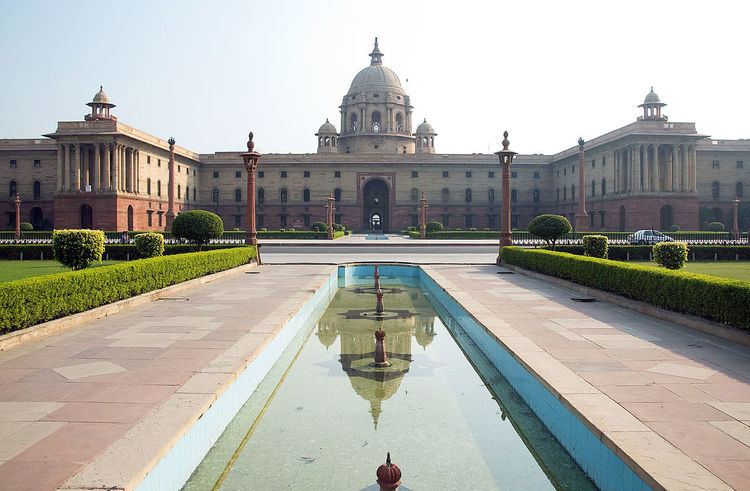Inaugural holder N. R. Pillai, ICS | ||
 | ||
Reports to Government of India
President's Secretariat
Vice President's Secretariat
Prime Minister's Office
Cabinet of India
Parliament of India Residence South Block, Secretariat Building, New Delhi Seat Cabinet Secretariat of India, South Block, New Delhi, India Appointer Prime Minister of India
The cabinet secretary is usually the senior most IAS officer of the senior most batch. The appointee for the office is approved by Appointments Committee of the Cabinet headed by Prime Minister, based on appointee's ability and strong confidence with Prime Minister Term length No fixed tenure is imposed on the office but term can be extended | ||
The Cabinet Secretary is a post and a rank in the Government of India. Cabinet Secretary is the top most executive official and senior-most civil servant in India. The Cabinet Secretary is the ex-officio head of the Civil Services Board, the Cabinet Secretariat, the Indian Administrative Service (IAS) and head of all civil services under the rules of business of the Government of India.
Contents
The Cabinet Secretary is under the direct charge of the Prime Minister. Though there is no fixed tenure, the average tenure of the Cabinet Secretary has been less than 3 years. His or her tenure however, can be extended.He doesn't belong to any particular ministry.
Origin
During British colonial rule in India, the agency that carried out governmental business was called the Governor-General-in Council. In 1946, the Council was renamed the Cabinet Secretariat.
After Independence in 1947, the functions of the Secretariat underwent major changes. A series of committees on economic, defence and intelligence matters were constituted under the Cabinet Secretariat. Most of the departments created after Independence functioned under the Cabinet Secretariat, and were later on shifted to the respective ministries. The position holder is accountable for ensuring that the civil service is equipped with the skills and capability to meet the everyday challenges it faces and that civil servants work in a fair and decent environment.
Functions
The following are the functions of a Cabinet Secretary:
Power and Role in Government
In the Government of India Allocation of Business Rules, 1961 "Cabinet Secretariat" finds a place in the First Schedule to the Rules. The subjects allotted to this Secretariat are, firstly, secretarial assistance to Cabinet and Cabinet Committees, and secondly, the administration of the Rules of Business.
The Cabinet Secretariat is responsible for the administration of the Government of India Transaction of Business Rules, 1961 and the Government of India Allocation of Business Rules 1961, facilitating smooth transaction of business in Ministries/Departments of the Government by ensuring adherence to these rules. The Secretariat assists in decision-making in Government by ensuring Inter-Ministerial coordination, ironing out differences amongst Ministries/Departments and evolving consensus through the instrumentality of the standing/adhoc Committees of Secretaries. Through this mechanism new policy initiatives are also promoted.
The Cabinet Secretariat ensures that the President of India, the Vice-President and Ministers are kept informed of the major activities of all Departments by means of a monthly summary of their activities. Management of major crisis situations in the country and coordinating activities of the various Ministries in such a situation is also one of the functions of the Cabinet Secretariat.
The Cabinet Secretariat has 3 wings: Civil, Military and Intelligence. The Civil wing is the main wing and provides aid, advice and assistance to the Union Cabinet. The purpose of having the Military wing is to provide better coordination in Intelligence and to provide secretarial assistance to the Defence Committee of the Cabinet and the National Defence Council. The Military wing is represented by Major General (or equivalent) who is designated as Joint Secretary in the Cabinet Secretariat. The Intelligence wing deals with matters pertaining to the Joint Intelligence Committee of the Union Cabinet. The chief of Research and Analysis Wing R&AW also officially first reports to the Cabinet Secretary, and is officially designated Secretary(R) in the Cabinet Secretariat.
Head of the All India Civil Services
As head of the All India Civil Services, the incumbent position holder is accountable for ensuring that the Civil Services are equipped with the skills and capability to meet the everyday challenges it faces and that civil servants work in a fair and decent environment. The Cabinet Secretary is arguably India's most powerful bureaucrat and right hand of Prime Minister of India.
